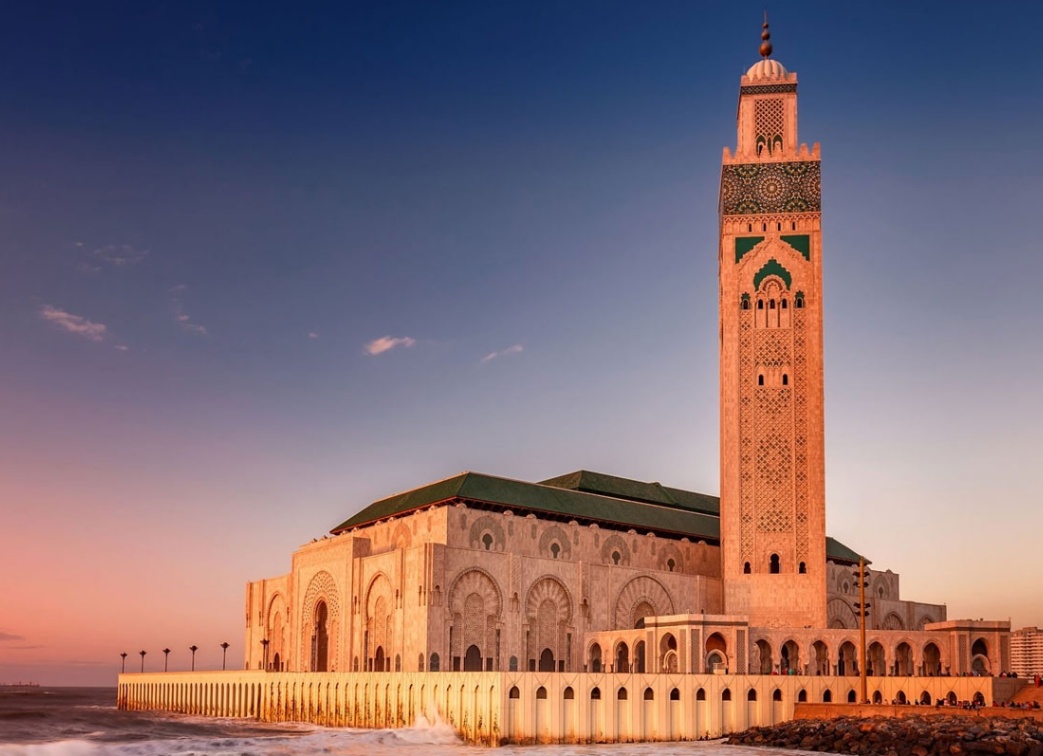Hassan II Mosque: A Monumental Symbol of Moroccan Spirituality and Craftsmanship
Table of Contents
Introduction to Hassan II Mosque
Located on the shores of the Atlantic Ocean in Casablanca, Morocco, the Hassan II Mosque stands as one of the largest mosques in the world and an architectural masterpiece of Islamic art and Moroccan craftsmanship. This magnificent structure not only serves as a place of worship but also as a symbol of Moroccan identity and religious devotion. Commissioned by King Hassan II in 1980, the mosque was completed in 1993, designed to endure as a cultural and spiritual legacy for generations.
Architectural Grandeur
The Hassan II Mosque is renowned for its breathtaking architecture, combining traditional Moroccan design with modern technology, and incorporating materials sourced from all over Morocco. The mosque was designed by the French architect Michel Pinseau and built by the Bouygues construction company. It is a testament to the skill of over 10,000 artisans who worked tirelessly to carve intricate woodwork, sculpt detailed marble pieces, and assemble vast mosaics.
Key Features
- Minaret: The mosque’s minaret is the tallest in the world, standing at 210 meters (689 feet). It is topped with a laser that points towards Mecca, serving both a religious and technological marvel.
- Prayer Hall: The prayer hall is massive, capable of accommodating up to 25,000 worshippers. The hall is adorned with handcrafted marble, vibrant mosaics, and a retractable roof that opens to the sky, blending natural elements with the prayer space.
- Courtyard: Surrounding the prayer hall is a vast courtyard that can hold an additional 80,000 people. The courtyard’s floor is covered with beautiful green tiles, and it offers stunning views of the Atlantic Ocean.
Craftsmanship and Artistry
The construction of the Hassan II Mosque showcases the pinnacle of Moroccan artistry. The interiors are a testament to the craftsmanship passed down through generations. Intricate zellij (tilework), elaborate wood carvings, and gilded cedar ceilings reflect the traditional styles of Moroccan architecture while embracing modern engineering techniques.
Materials
Materials for the mosque’s construction were sourced from various regions of Morocco, promoting national unity and pride. Marble from Agadir, cedar wood from the Middle Atlas, and granite from Tafraoute were all used, highlighting the mosque’s all-Moroccan character.
Cultural and Spiritual Significance
The Hassan II Mosque is not only an architectural feat but also a spiritual beacon for Islam in Morocco. It reflects King Hassan II’s vision to create a monument reflecting Morocco’s historical and religious heritage. The mosque’s location by the sea is symbolic, with the King stating that “the throne of God was on the water,” which inspired the mosque’s placement over the Atlantic waves. This monumental building serves as a center for religious education and a venue for significant cultural exchanges.
Public Access and Tours
Unlike many mosques, the Hassan II Mosque is open to non-Muslims through guided tours that are available several times a day. These tours offer insights into the Islamic faith, Moroccan culture, and the architectural details of the mosque, making it a pivotal destination for cultural tourism in Morocco.
Environmental Aspects
The mosque incorporates several modern and environmentally sustainable features. Its glass floor, which overlooks the sea, and the partially open roof allow natural light to illuminate the prayer space, reducing the need for artificial lighting and promoting energy conservation.
Challenges and Preservation
Maintaining such an expansive and intricately designed structure is not without challenges. The marine setting of the mosque exposes it to saltwater erosion, requiring ongoing maintenance to preserve its beauty and structural integrity. Efforts are continually made to ensure that the mosque remains a lasting symbol of Morocco’s architectural and spiritual heritage.
Conclusion
The Hassan II Mosque in Casablanca is more than just a place of worship; it is a monumental tribute to Moroccan culture, art, and faith. Its stunning architecture and spiritual significance make it a landmark of not only national pride but also international admiration. Whether you visit to partake in prayer, to admire the artistry, or to learn about Moroccan culture, the Hassan II Mosque offers a profound glimpse into the soul of Morocco.
Additional Resources
For those looking to delve deeper into Casablanca’s cultural scene, a visit to the Villa of Arts is highly recommended. This art gallery and cultural center hosts a variety of contemporary art exhibitions and cultural events, showcasing both established and emerging Moroccan artists. Additionally, for a touch of cinematic history blended with modern-day elegance, Rick’s Café offers a unique dining experience. Inspired by the classic film “Casablanca,” this stylish restaurant and bar recreates the movie’s famous setting, providing guests with a nostalgic yet upscale atmosphere. Both venues enrich Casablanca’s cultural landscape, offering distinct yet complementary experiences of the city’s artistic and historical charm.
As Seen On:
Official Private Driver Morocco has been featured or mentioned by leading media outlets including Business Insider, Street Insider, Central Charts, Yahoo Finance, Bar Chart, and Market Watch, recognizing our commitment to premium transportation services and exceptional customer experience.




United Nations Square: A Cultural Crossroads In The Heart Of Casablanca - Private Driver Morocco
[…] further enrich your exploration of Casablanca, consider visiting the iconic Hassan II Mosque and the Church of Notre Dame de Lourdes. The Hassan II Mosque, one of the largest mosques in the […]
Mohammed V Square: The Cultural And Historical Heart Of Casablanca - Private Driver Morocco
[…] Casablanca’s architectural and cultural landmarks, nearby attractions such as the Hassan II Mosque and Notre Dame Lourdes offer further insights into the city’s historical and religious […]
Rick's Café: Recapturing The Romance Of Casablanca - Private Driver Morocco
[…] visitors interested in exploring more of Casablanca’s attractions, the nearby Hassan II Mosque and the Casablanca Medina offer further insights into the city’s rich history and vibrant […]